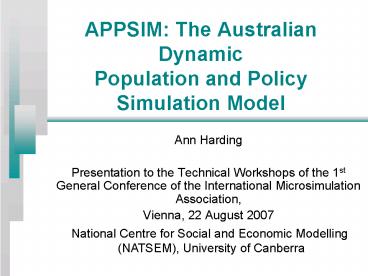APPSIM: The Australian Dynamic Population and Policy Simulation Model - PowerPoint PPT Presentation
1 / 8
Title: APPSIM: The Australian Dynamic Population and Policy Simulation Model
1
APPSIM The Australian DynamicPopulation and
PolicySimulation Model
- Ann Harding
- Presentation to the Technical Workshops of the
1st General Conference of the International
Microsimulation Association, - Vienna, 22 August 2007
National Centre for Social and Economic
Modelling (NATSEM), University of Canberra
2
The Australian Population and Policy Simulation
Model (APPSIM)
- 5 year project, started in late 2005
- Funded by the Australian Research Council and 13
Commonwealth agencies - Base data is 2001 Census one per cent sample file
(188,000 people), stored in Microsoft Access
databse - Parameters stored in Excel spreadsheets and
language is C - Full population model, with individuals being
aged to about 2050 discrete yearly time unit
3
The overall design and flow of APPSIM
4
Processes to be modelled within APPSIM
V0.2 8 Feb 2006
5
Other characteristics
- HILDA panel data being used to estimate
transition probabilities 5 years of data, 7000
households, sample size problems - Alignment required to match ABS population
projections and Treasury Intergenerational Report
labour force projections - Facility to turn alignment on or off within
each module - User friendly interface and output envisaged
- Ability to run sub-set of sample only and write
to output yearly, 5 yearly, 10 yearly or at end
of simulation
6
(No Transcript)
7
(No Transcript)
8
Issues for possible discussion
- How much alignment are others doing? Is it broad
alignment (e.g. total number of babies) or very
detailed alignment (e.g. number of babies by
mothers age and marital status)? How well do the
micro equations perform without alignment? What
is technique used to align? - Marriage market any updates on what works and
is efficient to run? - Problems creating the requisite histories for
people? - How successful has statistical matching been?
- How have others modelled labour markets sub
year output? - Any hints on modelling earnings or education or
assets? - How have others modelled health status and what
processes does it affect within model?































